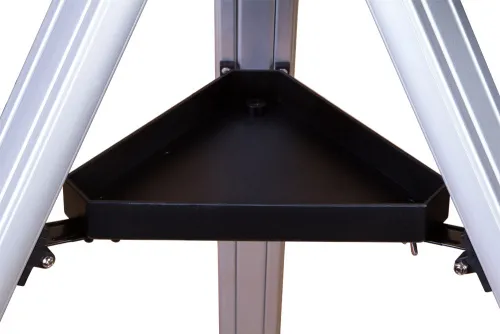Levenhuk Skyline BASE 100S Telescope
Newtonian reflector. Aperture: 102mm. Focal length: 700mm
| Product ID | 72851 |
| Brand | Levenhuk, Inc., USA |
| Warranty | lifetime |
| EAN | 5905555002316 |
| Package size (LxWxH) | 89x35x25 cm |
| Shipping Weight | 6.15 kg |
Levenhuk Skyline BASE 100S is a Newtonian reflector on an alt-azimuth mount. On the one hand, it is a user-friendly optical instrument that is simple to operate even for beginner-level astronomers; on the other hand, it allows you to conduct deep-sky observations. The telescope will be highly appreciated by amateur astronomers who are already familiar with astronomical observations, but who do not yet have enough experience to master a more complex optical device. Levenhuk Skyline BASE 100S is the right choice for those who are willing to dive right into the endless world of nebulae, galaxies, and star clusters.
Although this telescope is designed for deep space observations, you can also use it for viewing the Moon and the planets of the solar system. The kit includes two eyepieces that can be used interchangeably to optimally adjust the optics to different space objects. A 6x optical finderscope allows for pointing an optical tube precisely at the desired areas.
This telescope is equipped with an alt-azimuth mount, so it does not take much time to master it. Levenhuk Skyline BASE 100S is operated as a classic spotting scope by moving an optical tube to the left, right, up, and down. The mount is fixed on a standard tripod made of aluminum and, therefore, it is stable even standing on rough surfaces. The kit comes with an accessory tray. The tripod legs are extendable.
Features:
- Classic refractor on an alt-azimuth mount
- Useful and simple operation makes the telescope suitable for beginners
- An optimal choice for exploring deep-sky objects: observe all Messier objects and the brightest NGC objects
- You can observe the Solar system planets and the Moon
- The kit includes eyepieces that show all telescope capabilities
The kit includes:
- Telescope optical tube
- Alt-azimuth mount
- Aluminum tripod with an accessory tray
- 5x24 optical finder scope
- SR4mm (175x) eyepiece
- H20mm (35x) eyepiece
- User manual and lifetime warranty
| Product ID | 72851 |
| Brand | Levenhuk, Inc., USA |
| Warranty | lifetime |
| EAN | 5905555002316 |
| Package size (LxWxH) | 89x35x25 cm |
| Shipping Weight | 6.15 kg |
| Optical design | reflector |
| Optical scheme | Newtonian |
| Optics material | optical glass |
| Optics coating | standard |
| Primary mirror diameter (aperture), mm | 102 |
| Focal length, mm | 700 |
| Highest practical power, x | 204 |
| Aperture ratio | f/7 |
| Limiting stellar magnitude | 12.14 |
| Eyepieces | H20mm (35х), SR4mm (175х) |
| Eyepiece barrel diameter, in | 1.25 |
| Finderscope | optical, 5x24 |
| Tripod | aluminum |
| Tripod height (adjustable), mm | adjustable |
| Accessory tray | ✓ |
| Telescope control | manual |
| Mount | alt-azimuth, AZ2 |
| Optical tube material | aluminum |
| User level | beginners, experienced users |
| Assembly and installation difficulty level | easy |
| Observed object | deep-sky objects |
Convenient diagrams that describe how to install additional accessories on refractors and catadioptric telescopes
Find out how to assemble a telescope on an example of the Levenhuk Skyline 90x900 EQ telescope
This short guide will help you avoid typical mistakes and learn more about telescope and mounting types
The basics of astronomical observations for beginners
In this article we have gathered answers to some of the most frequently asked questions about telescopes
The most interesting celestial objects you can observe with Levenhuk telescopes
How telescopes work?
You can actually perform observations from your balcony!
All about telescope sizes, types, magnification, and mounts
Learn how to set up and use the telescope properly
Astronomy in light-polluted skies. Find out what you can observe in the city
Read an interesting comprehensive article on telescopes for little astronomers
The pictures are made with Levenhuk telescopes
Celestial objects you can observe with telescopes of different apertures
Colored and vivid images of galaxies, planets and star clusters entrance everyone who is fascinated by boundless space
Find an interesting review on the history of the changes to a refracting telescope
To make the process of choosing a telescope easier, we will tell you about the characteristics of the most popular types of telescopes today
Learn everything you need to know about refractor telescopes to make the right choice



















